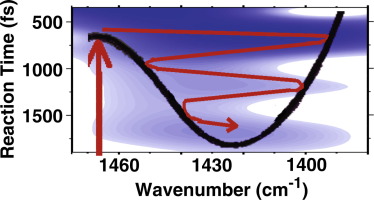Chemical Physics ( IF 2.0 ) Pub Date : 2017-12-28 , DOI: 10.1016/j.chemphys.2017.12.016 Sena Hashimoto , Atsushi Yabushita , Takayoshi Kobayashi , Kotaro Okamura , Izumi Iwakura

|
Photoexcitation of 9,9′-bianthryl has been considered to produce a locally excited (LE) state and then a charge transfer (CT) state by intramolecular charge transfer (ICT) in polar solvents. In contrast, the CT state is considered to be unstable in non-polar solvents and triggers a dipole flip-flop between the two anthracene rings. The central C–C bond between the two anthracene rings is considered to twist during relaxation in the LE state and CT state, and this was visualized in the present work using an ultrashort ultraviolet (UV) pulse. The C–C stretching frequency was recovered in a period of ca. 500 fs, which implies that the C–C bond undergoes repeated torsion back and forth in the electronic excited state. Investigation of samples in a polar solvent and a non-polar solvent indicated that ICT does not affect the torsion around the central C–C bond.
中文翻译:

使用10 fs脉冲紫外激光直接观察9,9'-联蒽的瞬态分子结构的变化
9,9'-双蒽基的光激发被认为会在极性溶剂中通过分子内电荷转移(ICT)产生局部激发(LE)状态,然后产生电荷转移(CT)状态。相反,在非极性溶剂中,CT状态被认为是不稳定的,并且会触发两个蒽环之间的偶极触发器。两个蒽环之间的中央C–C键被认为在LE状态和CT状态下的弛豫过程中发生了扭曲,并且在本研究中使用超短紫外线(UV)脉冲将其可视化。C–C拉伸频率在大约一个周期内恢复。500 fs,这意味着CC键在电子激发态下反复来回扭转。











































 京公网安备 11010802027423号
京公网安备 11010802027423号